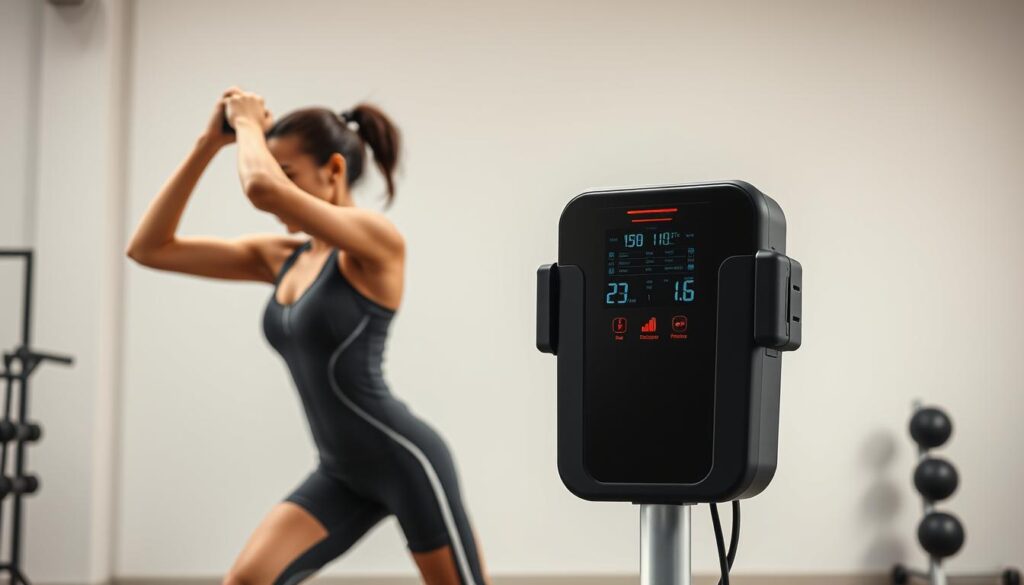
Best EMS Muscle Suit: Benefits and Risks Explained
Imagine stepping into a gym for the first time, feeling overwhelmed by the equipment and unsure where to start. That’s how Sarah felt until she discovered a unique solution—a device that promised to enhance her workout without hours of lifting weights. This device, known as an EMS suit, uses low-frequency electrical impulses to stimulate muscle contractions, mimicking the effects of traditional exercise1.
EMS technology has evolved significantly since its origins in the 1960s. Today, it’s a wireless, at-home solution that activates up to 90% of muscle fibers in just 20 minutes1. While it offers convenience and efficiency, it’s essential to understand both its benefits and risks. This article provides an unbiased review of the best options available, focusing on safety and effectiveness.
Key Takeaways
- EMS suits use electrical impulses to stimulate muscle contractions.
- They can activate up to 90% of muscle fibers in a short time.
- Modern systems are wireless and designed for at-home use.
- Benefits include time efficiency and full-body workouts.
- Risks include potential muscle damage if not used correctly.
- Professional supervision is recommended for beginners.
- Scientific research supports its effectiveness for certain populations.
Introduction to EMS Muscle Stimulation Training
In recent years, fitness enthusiasts have embraced a revolutionary approach to exercise that combines technology and efficiency. Known as electrical muscle stimulation (EMS), this method uses low-frequency impulses to activate muscle fibers, offering a unique alternative to traditional workouts2.
EMS works by sending electrical signals to major muscle groups, causing them to contract. This process mimics natural muscle activation but with higher intensity, engaging up to 90% of muscle fibers simultaneously2. Unlike conventional gym sessions, EMS achieves these results in just 20 minutes, making it a time-efficient solution for busy individuals3.
Overview of EMS Technology
At its core, EMS technology is designed to enhance muscle engagement without the need for heavy equipment. The device integrates smart features like wireless connectivity and app-based controls, allowing users to customize their sessions2. This adaptability makes it suitable for various fitness levels, from beginners to athletes.
Studies have shown that EMS can replicate the benefits of a 90-minute gym session in just 20 minutes3. This efficiency has contributed to its growing popularity, especially among those seeking quick yet effective workouts. Additionally, EMS is gentle on joints, making it a viable option for individuals with physical limitations2.
Why EMS is Gaining Popularity
The rise of EMS can be attributed to its convenience and effectiveness. With sessions lasting only 20 minutes per week, it fits seamlessly into busy schedules3. Its ability to target multiple muscle groups simultaneously ensures a full-body workout, enhancing strength and endurance over time2.
“EMS training has revolutionized the way we approach fitness, offering a blend of efficiency and innovation that traditional methods cannot match.”
However, it’s crucial to use EMS devices correctly to avoid potential risks. Professional guidance is recommended, especially for beginners, to ensure safe and effective use4. As this technology continues to evolve, it’s clear that EMS is more than just a trend—it’s a transformative approach to fitness.
Understanding the Technology Behind EMS
The science behind electrical muscle stimulation (EMS) reveals a fascinating blend of biology and technology. By sending low-frequency electrical impulses, EMS devices mimic the natural signals sent by the nervous system to activate muscle fibers5. This process engages both slow-twitch and fast-twitch fibers, which are essential for strength and endurance5.

The Science of Electrical Muscle Contraction
EMS works by targeting major muscle groups with precise electrical pulses. These pulses cause muscles to contract, simulating the effects of traditional exercise but with greater intensity6. Studies show that EMS can activate up to 90% of muscle fibers, compared to just 40% with conventional methods7.
This technology is particularly effective for rehabilitation, as it helps “re-teach” the brain how to activate muscles after injury5. It also reaches deep muscle layers, which are harder to engage through regular training5.
How EMS Differs from Traditional Workouts
Unlike traditional workouts, EMS focuses on both fast-twitch and slow-twitch fibers simultaneously6. This dual activation leads to more comprehensive muscle engagement and faster results7. Additionally, EMS sessions are shorter, often lasting just 20 minutes, yet they can replicate the benefits of a 90-minute gym session6.
Modern EMS devices integrate advanced features like wireless control and app connectivity, allowing users to customize their sessions for optimal results6. These innovations make EMS a versatile option for fitness enthusiasts and athletes alike.
“EMS training offers a unique combination of efficiency and precision, making it a valuable tool for modern fitness routines.”
With improved electrode placement and battery optimization, EMS technology continues to evolve, supporting its broader use in daily fitness routines6. Whether for strength training, recovery, or general fitness, EMS provides a scientifically backed alternative to traditional methods.
History and Evolution of EMS Suits
The journey of electrical muscle stimulation (EMS) technology began decades ago, rooted in scientific research and innovation. Initially developed in the 1960s, EMS was primarily used for rehabilitation and training purposes, with significant contributions from Russian researchers8. Early devices were bulky and wired, limiting their accessibility and practicality.
Over the years, EMS technology evolved from cumbersome equipment to sleek, wireless systems. Improvements in electrode placement and battery efficiency transformed these devices into user-friendly solutions for home use8. Modern EMS suits now integrate advanced features like app-based controls, allowing users to customize their sessions for optimal results.
From Early Developments to Modern Innovations
In the early stages, EMS was primarily used in clinical settings for muscle rehabilitation. Researchers discovered that electrical impulses could activate muscle fibers, mimicking natural contractions8. This breakthrough laid the foundation for its application in fitness and training.
By the 2000s, EMS technology had gained traction in the fitness industry. Renowned sports figures and trainers began endorsing its effectiveness, further boosting its popularity8. The introduction of wireless systems and improved battery life made these devices more accessible to the general public.
Today, EMS suits are celebrated for their efficiency and advanced features. A 20-minute session can replicate the benefits of a 90-minute gym workout, making it a time-efficient solution for busy individuals9. The global EMS market is projected to grow by 51%, reaching $184 million by 2030, reflecting its widespread adoption8.
“The evolution of EMS technology has transformed it from a niche rehabilitation tool to a mainstream fitness solution.”
Modern EMS suits, like the Katalyst system, engage up to 90% of muscle fibers in a single session, offering unparalleled results8. These advancements have made EMS a cornerstone of modern fitness routines, combining efficiency with cutting-edge technology. For more insights on the benefits of EMS technology, explore why investing in an Electrical Muscle Stimulation suit is a must in today’s fitness.
Exploring the Best EMS Muscle Suit Features
Modern fitness technology has introduced innovative solutions to enhance workout efficiency, with advanced features that cater to diverse user needs. These devices are designed to optimize muscle engagement and provide a seamless training experience, combining cutting-edge hardware with user-friendly software.

Key Components and Design Considerations
The core of an EMS suit lies in its hardware components. Strategically placed electrodes ensure precise targeting of major muscle groups, maximizing engagement during each session10. Advanced battery systems provide extended usage, allowing users to complete multiple workouts without frequent recharging11.
Ergonomic design is another critical factor. These suits are engineered to fit securely on various body types, ensuring comfort and stability during intense sessions10. Safety protocols, such as adjustable intensity levels, minimize the risk of overstimulation, making the technology accessible to beginners and experienced users alike12.
User-Centric Functionality and App Integration
App integration is a standout feature of modern EMS suits. Users can customize their workouts, adjusting settings like intensity and duration to match their fitness goals11. The app also tracks progress, providing insights into muscle activation and overall performance10.
Wireless connectivity enhances convenience, allowing users to control their sessions from a smartphone or tablet11. This seamless integration ensures a personalized experience, making it easier to achieve desired results. For more tips on selecting the right EMS suit for your needs, explore this comprehensive guide.
In summary, the combination of advanced hardware, ergonomic design, and app integration makes EMS suits a powerful tool for modern fitness routines. These features collectively enhance the workout experience, delivering efficient and effective results12.
Benefits and Effectiveness of EMS Workouts
For those seeking a more efficient way to achieve fitness goals, EMS training offers a scientifically backed solution. This method combines advanced technology with time-saving benefits, making it a popular choice for busy individuals. By engaging multiple muscle groups simultaneously, it delivers results comparable to longer, traditional workouts13.
Time Efficiency and Full-Body Engagement
One of the standout features of EMS training is its ability to deliver full-body engagement in just 20 minutes. Research shows that a single session can activate up to 90% of muscle fibers, replicating the effects of a 90-minute gym workout14. This makes it an ideal option for those with limited time.
Additionally, EMS training is gentle on joints, reducing the risk of injury while maximizing results. Its ability to target deep muscle layers ensures a comprehensive workout, enhancing both strength and endurance15.
Impact on Muscle Strength and Recovery
EMS training has been shown to significantly improve muscle strength and recovery. A 2016 study found that participants using EMS during a six-week squat program experienced greater strength gains compared to those who relied on traditional methods13.
Moreover, EMS enhances blood circulation, which accelerates muscle recovery and reduces soreness. This makes it a valuable tool for athletes and fitness enthusiasts alike15. For a time-efficient home workout solution, EMS technology is a game-changer.
Risks, Safety, and Contraindications of EMS Training
While EMS training offers significant benefits, it’s crucial to understand the potential risks and safety measures involved. Like any fitness technology, improper use can lead to adverse effects, making it essential to follow guidelines and consult professionals16.

Potential Side Effects and Precautions
Common side effects of EMS training include skin irritation, muscle soreness, and elevated creatine kinase levels. In some cases, users have reported shocks, burns, and interference with medical devices like pacemakers16. These risks highlight the importance of starting at lower intensities and gradually increasing the workout load.
Proper session duration and intensity adjustments are critical to reducing adverse reactions. Consulting a healthcare professional before beginning EMS training is strongly recommended, especially for individuals with pre-existing conditions17.
Medical Guidelines for Safe EMS Use
Medical guidelines emphasize the need for professional supervision, particularly for beginners. The FDA regulates EMS devices, requiring compliance with safety standards to minimize risks like electrocution and device interference16. Users should ensure their equipment meets these standards.
Contraindications for EMS use include pregnancy, heart conditions, and the presence of electrical implants. For those with these conditions, alternative fitness methods should be considered16. For more insights on safe EMS practices, explore one-on-one EMS suit training.
“Safety must always be prioritized when using EMS technology. Informed and cautious use ensures maximum benefits while minimizing risks.”
In conclusion, while EMS training is effective, it requires careful attention to safety protocols. By following medical guidelines and consulting professionals, users can enjoy the benefits of this innovative fitness solution without compromising their health17.
Choosing the Right EMS Suit for Your Fitness Goals
Selecting the right fitness equipment can significantly impact your workout results and overall experience. When it comes to EMS suits, the choice depends on individual goals, whether for home use or professional training environments. Key factors like fit, technical compatibility, and app-driven customization play a crucial role in ensuring effectiveness and safety18.
Considerations for Home Versus Professional Use
EMS suits designed for home use prioritize convenience and ease of setup. These models often feature wireless connectivity and intuitive app controls, making them accessible for beginners18. In contrast, professional-grade suits, like the myostyle Smart Suit, offer advanced settings and durability for intensive use in studios19.
For home users, battery life is a critical factor. Look for suits with extended battery endurance to avoid interruptions during sessions18. Professional trainers, on the other hand, may prioritize adjustable impulse strength and multi-user capabilities to cater to diverse clients18.
Integration of Battery, App, and EMS Settings
Modern EMS suits integrate advanced features like app-based controls and customizable programs. These tools allow users to adjust intensity levels and track progress, enhancing the overall workout experience18. Devices with extended battery life and quick charging options ensure uninterrupted sessions, making them ideal for busy schedules18.
Safety features, such as compliance with medical DIN standards, are essential for both home and professional use19. Additionally, suits made from skin-friendly materials and antibacterial fabrics improve comfort and hygiene during intense sessions19.
“The right EMS suit can transform your fitness routine, offering efficiency and precision tailored to your goals.”
When choosing an EMS suit, review technical specifications and warranty information to ensure long-term satisfaction. Whether for home or professional use, the right selection will directly impact the effectiveness of your workout and overall fitness journey18.
Maintenance, Care, and Longevity of EMS Suits
Proper maintenance of fitness equipment ensures longevity and optimal performance, especially for advanced technologies like EMS suits. Regular care not only preserves the functionality of the device but also enhances hygiene and safety during workouts. Following manufacturer guidelines and expert advice is essential to maximize the lifespan of these innovative tools.

Cleaning and Washing Guidelines
Cleaning an EMS suit requires careful handling to protect its delicate components. Washing the suit on its own, using cold water and a gentle cycle, is recommended to prevent wear and tear20. Avoid bleach and fabric softeners, as they can damage the fabric and reduce electrode conductivity20.
For deeper cleaning, soaking the suit in cold water biweekly can help remove accumulated minerals21. A 15-minute laundry cycle at 40ºC is ideal for maintaining hygiene without compromising the suit’s integrity21. Air drying is preferred over using a dryer, as high heat can cause damage20.
Storage and Longevity Tips
Proper storage is crucial to prevent moisture-induced damage and ensure the suit’s longevity. Store the device in a cool, dry place to avoid mold and fungus development20. Disconnecting the control unit and detachable electrodes before washing is advised to prevent damage20.
Regular maintenance, such as scheduling checks and adhering to manufacturer guidelines, can significantly extend the suit’s lifespan20. By following these practices, users can ensure their EMS suit continues to function efficiently over time.
“Proper care and maintenance of EMS suits not only enhance their durability but also ensure consistent performance and hygiene during workouts.”
In summary, maintaining an EMS suit involves gentle cleaning, proper storage, and regular checks. These practices guarantee the device remains effective and safe, supporting users in achieving their fitness goals20.
Conclusion
Fitness technology continues to evolve, offering innovative solutions for efficient and effective training. This article has explored the benefits and risks of using advanced devices like EMS suits, emphasizing their ability to enhance workouts when used correctly. These tools can activate up to 90% of muscle fibers, providing results comparable to longer gym sessions22.
However, safety is paramount. Proper usage, professional guidance, and adherence to medical guidelines are essential to avoid potential risks such as muscle soreness or skin irritation23. For those considering this technology, BruteSuits.com offers reliable, FDA-approved products tailored for home use.
By combining this knowledge with personal fitness goals, users can make informed decisions. Explore detailed guides to find the most suitable option for your needs. Balancing enthusiasm with caution ensures a safe and effective fitness journey.